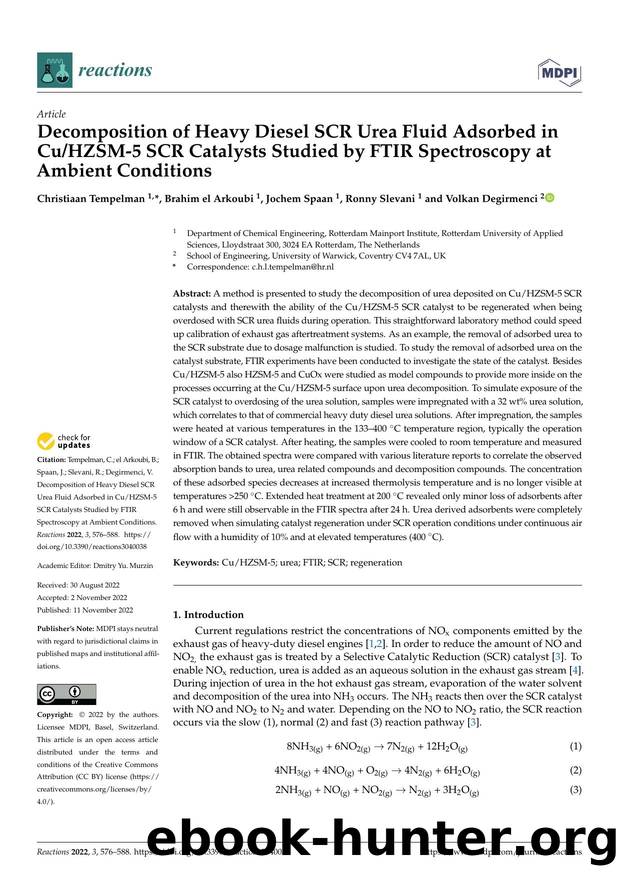Decomposition of Heavy Diesel SCR Urea Fluid Adsorbed in CuHZSM-5 SCR Catalysts Studied by FTIR Spectroscopy at Ambient Conditions by Christiaan Tempelman Brahim el Arkoubi Jochem Spaan Ronny Slevani & Volkan Degirmenci

Author:Christiaan Tempelman, Brahim el Arkoubi, Jochem Spaan, Ronny Slevani & Volkan Degirmenci
Format: pdf
Tags: A method is presented to study the decomposition of urea deposited on Cu/HZSM-5 SCR catalysts and therewith the ability of the Cu/HZSM-5 SCR catalyst to be regenerated when being overdosed with SCR urea fluids during operation. This straightforward laboratory method could speed up calibration of exhaust gas aftertreatment systems. As an example, the removal of adsorbed urea to the SCR substrate due to dosage malfunction is studied. To study the removal of adsorbed urea on the catalyst substrate, FTIR experiments have been conducted to investigate the state of the catalyst. Besides Cu/HZSM-5 also HZSM-5 and CuOx were studied as model compounds to provide more inside on the processes occurring at the Cu/HZSM-5 surface upon urea decomposition. To simulate exposure of the SCR catalyst to overdosing of the urea solution, samples were impregnated with a 32 wt% urea solution, which correlates to that of commercial heavy duty diesel urea solutions. After impregnation, the samples were heated at various temperatures in the 133–400 C temperature region, typically the operation window of a SCR catalyst. After heating, the samples were cooled to room temperature and measured in FTIR. The obtained spectra were compared with various literature reports to correlate the observed absorption bands to urea, urea related compounds and decomposition compounds. The concentration of these adsorbed species decreases at increased thermolysis temperature and is no longer visible at temperatures >250 C. Extended heat treatment at 200 C revealed only minor loss of adsorbents after 6 h and were still observable in the FTIR spectra after 24 h. Urea derived adsorbents were completely removed when simulating catalyst regeneration under SCR operation conditions under continuous air flow with a humidity of 10% and at elevated temperatures (400 C)., Cu/HZSM-5; urea; FTIR; SCR; regeneration
Download
This site does not store any files on its server. We only index and link to content provided by other sites. Please contact the content providers to delete copyright contents if any and email us, we'll remove relevant links or contents immediately.
What's Done in Darkness by Kayla Perrin(25507)
Shot Through the Heart: DI Grace Fisher 2 by Isabelle Grey(18227)
Shot Through the Heart by Mercy Celeste(18168)
The Fifty Shades Trilogy & Grey by E L James(17783)
The 3rd Cycle of the Betrayed Series Collection: Extremely Controversial Historical Thrillers (Betrayed Series Boxed set) by McCray Carolyn(13196)
The Subtle Art of Not Giving a F*ck by Mark Manson(12924)
Scorched Earth by Nick Kyme(11843)
Stepbrother Stories 2 - 21 Taboo Story Collection (Brother Sister Stepbrother Stepsister Taboo Pseudo Incest Family Virgin Creampie Pregnant Forced Pregnancy Breeding) by Roxi Harding(11061)
Drei Generationen auf dem Jakobsweg by Stein Pia(10223)
Suna by Ziefle Pia(10188)
Scythe by Neal Shusterman(9270)
International Relations from the Global South; Worlds of Difference; First Edition by Arlene B. Tickner & Karen Smith(8624)
Successful Proposal Strategies for Small Businesses: Using Knowledge Management ot Win Govenment, Private Sector, and International Contracts 3rd Edition by Robert Frey(8426)
This is Going to Hurt by Adam Kay(7713)
Dirty Filthy Fix: A Fixed Trilogy Novella by Laurelin Paige(6459)
He Loves Me...KNOT by RC Boldt(5809)
How to Make Love to a Negro Without Getting Tired by Dany LaFerrière(5387)
Interdimensional Brothel by F4U(5312)
Thankful For Her by Alexa Riley(5174)
